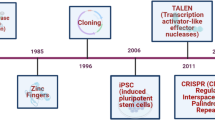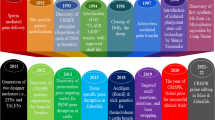Abstract
The clustered regularly interspaced short palindromic repeats (CRISPR)/CRISPR-associated gene (Cas) system is continually optimized to achieve the most efficient gene editing effect. The Cas12iMax, a Cas12i variant, exhibits powerful DNA editing activity and enriches the gene editing toolbox. However, the application of Cas12iMax in large domestic animals has not yet been reported. To verify the efficiency and feasibility of multiple gene editing in large animals, we generated porcine fibroblasts with simultaneous knockouts of IGF2, ANPEP, CD163, and MSTN via Cas12iMax in one step. Phenotypically stable pigs were created through somatic cell nuclear transfer technology. They exhibited improved growth performance and muscle quality. Furthermore, we simultaneously edited three genes in bovine fibroblasts. A knockout of MSTN and PRNP was created and the amino acid Q-G in CD18 was precisely substituted. Meanwhile, no off-target phenomenon was observed by sum-type analysis or off-target detection. These results verified the effectiveness of Cas12iMax for gene editing in livestock animals and demonstrated the potential application of Cas12iMax in the field of animal trait improvement for agricultural production.
Similar content being viewed by others
References
Anzalone, A.V., Koblan, L.W., and Liu, D.R. (2020). Genome editing with CRISPR-Cas nucleases, base editors, transposases and prime editors. Nat Biotechnol 38, 824–844.
Bae, S., Park, J., and Kim, J.S. (2014). Cas-OFFinder: a fast and versatile algorithm that searches for potential off-target sites of Cas9 RNA-guided endonucleases. Bioinformatics 30, 1473–1475.
Chen, Y., Hu, Y., Wang, X., Luo, S., Yang, N., Chen, Y., Li, Z., Zhou, Q., and Li, W. (2022). Synergistic engineering of CRISPR-Cas nucleases enables robust mammalian genome editing. Innovation 3, 100264.
Choi, W.J., Kim, E., Yum, S.Y., Lee, C.I., Lee, J.H., Moon, J.H., Ramachandra, S., Malaweera, B.O., Cho, J.K., Kim, J.S., et al. (2015). Efficient PRNP deletion in bovine genome using gene-editing technologies in bovine cells. Prion 9, 278–291.
Cong, L., Ran, F.A., Cox, D., Lin, S., Barretto, R., Habib, N., Hsu, P.D., Wu, X., Jiang, W., Marraffini, L.A., et al. (2013). Multiplex genome engineering using CRISPR/Cas systems. Science 339, 819–823.
Edraki, A., Mir, A., Ibraheim, R., Gainetdinov, I., Yoon, Y., Song, C.Q., Cao, Y., Gallant, J., Xue, W., Rivera-Pérez, J.A., et al. (2019). A compact, high-accuracy Cas9 with a dinucleotide PAM for in vivo genome editing. Mol Cell 73, 714–726.e4.
Etzerodt, A., Kjolby, M., Nielsen, M.J., Maniecki, M., Svendsen, P., and Moestrup, S.K. (2013). Plasma clearance of hemoglobin and haptoglobin in mice and effect of CD163 gene targeting disruption. Antioxid Redox Signal 18, 2254–2263.
Gim, G.M., Kwon, D.H., Eom, K.H., Moon, J.H., Park, J.H., Lee, W.W., Jung, D.J., Kim, D.H., Yi, J.K., Ha, J.J., et al. (2022). Production of MSTN-mutated cattle without exogenous gene integration using CRISPR-Cas9. Biotechnol J 17, e2100198.
Hansen, G.H., Delmas, B., Besnardeau, L., Vogel, L.K., Laude, H., Sjöström, H., and Norén, O. (1998). The coronavirus transmissible gastroenteritis virus causes infection after receptor-mediated endocytosis and acid-dependent fusion with an intracellular compartment. J Virol 72, 527–534.
Hille, F., Richter, H., Wong, S.P., Bratovič, M., Ressel, S., and Charpentier, E. (2018). The biology of CRISPR-Cas: backward and forward. Cell 172, 1239–1259.
Huang, X.J., Zhang, H.X., Wang, H., Xiong, K., Qin, L., and Liu, H. (2014). Disruption of the myostatin gene in porcine primary fibroblasts and embryos using zinc-finger nucleases. Mol Cells 37, 302–306.
Jin, Q., Yang, X., Gou, S., Liu, X., Zhuang, Z., Liang, Y., Shi, H., Huang, J., Wu, H., Zhao, Y., et al. (2022). Double knock-in pig models with elements of binary Tet-On and phiC31 integrase systems for controllable and switchable gene expression. Sci China Life Sci 65, 2269–2286.
Kim, D.Y., Lee, J.M., Moon, S.B., Chin, H.J., Park, S., Lim, Y., Kim, D., Koo, T., Ko, J.H., and Kim, Y.S. (2022). Efficient CRISPR editing with a hypercompact Cas12f1 and engineered guide RNAs delivered by adeno-associated virus. Nat Biotechnol 40, 94–102.
Kleinstiver, B.P., Prew, M.S., Tsai, S.Q., Nguyen, N.T., Topkar, V.V., Zheng, Z., and Joung, J.K. (2015). Broadening the targeting range of Staphylococcus aureus CRISPR-Cas9 by modifying PAM recognition. Nat Biotechnol 33, 1293–1298.
Liu, J.J., Orlova, N., Oakes, B.L., Ma, E., Spinner, H.B., Baney, K.L.M., Chuck, J., Tan, D., Knott, G.J., Harrington, L.B., et al. (2019). CasX enzymes comprise a distinct family of RNA-guided genome editors. Nature 566, 218–223.
Luo, L., Wang, S., Zhu, L., Fan, B., Liu, T., Wang, L., Zhao, P., Dang, Y., Sun, P., Chen, J., et al. (2019). Aminopeptidase N-null neonatal piglets are protected from transmissible gastroenteritis virus but not porcine epidemic diarrhea virus. Sci Rep 9, 13186.
Makarova, K.S., Wolf, Y.I., Iranzo, J., Shmakov, S.A., Alkhnbashi, O.S., Brouns, S.J.J., Charpentier, E., Cheng, D., Haft, D.H., Horvath, P., et al. (2020). Evolutionary classification of CRISPR-Cas systems: a burst of class 2 and derived variants. Nat Rev Microbiol 18, 67–83.
Moon, S.B., Kim, D.Y., Ko, J.H., and Kim, Y.S. (2019). Recent advances in the CRISPR genome editing tool set. Exp Mol Med 51, 1–11.
Petersen, B. (2017). Basics of genome editing technology and its application in livestock species. Reprod Domest anims 52, 4–13.
Ran, F.A., Cong, L., Yan, W.X., Scott, D.A., Gootenberg, J.S., Kriz, A.J., Zetsche, B., Shalem, O., Wu, X., Makarova, K.S., et al. (2015). In vivo genome editing using Staphylococcus aureus Cas9. Nature 520, 186–191.
Rashid, T., Kobayashi, T., and Nakauchi, H. (2014). Revisiting the flight of icarus: making human organs from PSCs with large animal chimeras. Cell Stem Cell 15, 406–409.
Ren, J., Yu, D., Fu, R., An, P., Sun, R., Wang, Z., Guo, R., Li, H., Zhang, Y., Li, Z., et al. (2020). IL2RG-deficient minipigs generated via CRISPR/Cas9 technology support the growth of human melanoma-derived tumours. Cell Prolif 53, e12863.
Ren, J., Yu, D., Wang, J., Xu, K., Xu, Y., Sun, R., An, P., Li, C., Feng, G., Zhang, Y., et al. (2022). Generation of immunodeficient pig with hereditary tyrosinemia type 1 and their preliminary application for humanized liver. Cell Biosci 12, 26.
Shanthalingam, S., and Srikumaran, S. (2009). Intact signal peptide of CD18, the β-subunit of β2-integrins, renders ruminants susceptible to Mannheimia haemolytica leukotoxin. Proc Natl Acad Sci USA 106, 15448–15453.
Shanthalingam, S., Tibary, A., Beever, J.E., Kasinathan, P., Brown, W.C., and Srikumaran, S. (2016). Precise gene editing paves the way for derivation of Mannheimia haemolytica leukotoxin-resistant cattle. Proc Natl Acad Sci USA 113, 13186–13190.
Song, R., Wang, Y., Zheng, Q., Yao, J., Cao, C., Wang, Y., and Zhao, J. (2022). One-step base editing in multiple genes by direct embryo injection for pig trait improvement. Sci China Life Sci 65, 739–752.
Strecker, J., Jones, S., Koopal, B., Schmid-Burgk, J., Zetsche, B., Gao, L., Makarova, K. S., Koonin, E.V., and Zhang, F. (2019). Engineering of CRISPR-Cas12b for human genome editing. Nat Commun 10, 212.
Walton, R.T., Christie, K.A., Whittaker, M.N., and Kleinstiver, B.P. (2020). Unconstrained genome targeting with near-PAMless engineered CRISPR-Cas9 variants. Science 368, 290–296.
Whitworth, K.M., Rowland, R.R.R., Ewen, C.L., Trible, B.R., Kerrigan, M.A., Cino-Ozuna, A.G., Samuel, M.S., Lightner, J.E., McLaren, D.G., Mileham, A.J., et al. (2016). Gene-edited pigs are protected from porcine reproductive and respiratory syndrome virus. Nat Biotechnol 34, 20–22.
Xiang, G., Ren, J., Hai, T., Fu, R., Yu, D., Wang, J., Li, W., Wang, H., and Zhou, Q. (2018). Editing porcine IGF2 regulatory element improved meat production in Chinese Bama pigs. Cell Mol Life Sci 75, 4619–4628.
Xu, K., Zhou, Y., Mu, Y., Liu, Z., Hou, S., Xiong, Y., Fang, L., Ge, C., Wei, Y., Zhang, X., et al. (2020). CD163 and pAPN double-knockout pigs are resistant to PRRSV and TGEV and exhibit decreased susceptibility to PDCoV while maintaining normal production performance. eLife 9, e57132.
Yan, W.X., Hunnewell, P., Alfonse, L.E., Carte, J.M., Keston-Smith, E., Sothiselvam, S., Garrity, A.J., Chong, S., Makarova, K.S., Koonin, E.V., et al. (2019). Functionally diverse type V CRISPR-Cas systems. Science 363, 88–91.
Yu, Z., Jiang, S., Wang, Y., Tian, X., Zhao, P., Xu, J., Feng, M., and She, Q. (2021). CRISPR-Cas adaptive immune systems in Sulfolobales: genetic studies and molecular mechanisms. Sci China Life Sci 64, 678–696.
Acknowledgement
This work was supported by the National Key Research and Development Program of China (2018YFE0201100, 2021YFA0805905, 2021YFA0805701, 2022YFA1103101), the National Natural Science Foundation of China (32102549), the National Key R&D Program of Ningxia (2021BEF02023), the China Agriculture Research System of MOF and MARA (CARS-36), the Agricultural Science and Technology Innovation Program (ASTIP-IAS06), the project from The Xinjiang Production and Construction Corps and Foundation of State Key Laboratory for Sheep Genetic Improvement and Healthy Production (2021ZD04). We express our gratitude to Prof. Aihua Zheng for his valuable assistance during the virus resistance experiments conducted on the model pigs. Additionally, we extend our appreciation to the staff of the Beijing Farm Animal Research Center for their diligent husbandry of the model pigs.
Author information
Authors and Affiliations
Corresponding authors
Ethics declarations
The author(s) declare that they have no conflict of interest.
Electronic supplementary material
Rights and permissions
About this article
Cite this article
Ren, J., Hai, T., Chen, Y. et al. Improve meat production and virus resistance by simultaneously editing multiple genes in livestock using Cas12iMax. Sci. China Life Sci. 67, 555–564 (2024). https://doi.org/10.1007/s11427-023-2407-0
Received:
Accepted:
Published:
Issue Date:
DOI: https://doi.org/10.1007/s11427-023-2407-0




